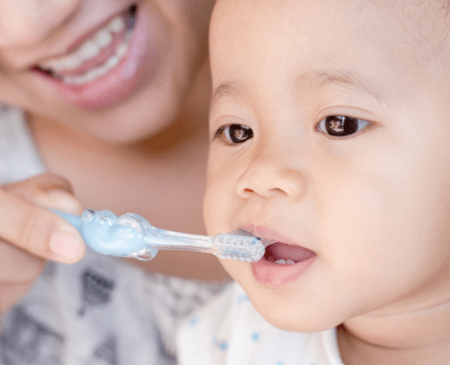Brushing at every age
In their first decade of life, your child’s teeth will come and go… and come again!
That’s a lot of quick movement and growth. And with this comes a need for an ever-changing tooth brushing regime – setting your child up for healthy chompers into adulthood.
These changes can be tricky to keep up with. That is of course, if you’re not getting the right advice.
From gummy grins to sparkly smiles, here’s our guide to looking after your child’s teeth at each stage of their tooth brushing journey.
Stage 1: Not a tooth in sight

Even before the first tooth appears, you’ll need to start wiping your baby’s gums twice daily
You might be surprised to hear it, but you need to start your baby on their oral hygiene journey before the first sparkle of a tooth shows.
Why? Because your baby’s mouth needs to be healthy and ready for when that first tooth starts popping through. All mouths have bacteria, but one particular type of bacteria can put some infants at a high risk of developing decay.
Frequent cleaning helps keep this microscopic nasty under control. And, bacteria aside, it’s also a good idea to establish cleaning habits from the get-go – making the transition to brushing easier later on.
You might be asking, ‘How can you clean non-existent teeth?’
Good question.
From birth, we recommend cleaning your baby’s gums twice a day. You can do this gently and safely by wrapping a clean face washer or gauze around your index finger and gently wiping your child’s gum and tongue with room temperature water.
These changes can be tricky to keep up with. That is of course, if you’re not getting the right advice.
From gummy grins to sparkly smiles, here’s our guide to looking after your child’s teeth at each stage of their tooth brushing journey.
Stage 2: Teeth start poking through
Remember, baby teeth can still decay. Believe it or not, as paediatric dentists we see children as young as 12-18 months with decayed teeth.
That’s why brushing thoroughly (and making regular dentist appointments) is crucial to their overall oral health.
Using either a cloth or a kid’s toothbrush, brush twice a day for two minutes with just water. You can then introduce a low fluoride toothpaste at 18 months.
And if you’re using a toothbrush, be sure to clean it thoroughly after use and allow it to dry in a container. As soon as the brush becomes worn or frayed, replace it. This will likely be every three or four months.

You’ll likely see the first glimmer of a tooth around 6-10 months of age. These first teeth are often the lower front teeth. And from this point, the tooth cleaning regime must truly begin!
Stage 3: Handing over the toothbrush
In most cases, children will have a full set of baby teeth by the age of three.
So grown up! And they will think so too.
Which means it’s no surprise that many kids at this age want to partake in the brushing routine – and it’s a good idea to let them.
But remember their motor skills are still developing, which means they won’t get all the nooks and crannies that you can. So while you can’t let them take the reins just yet, you can get them helping.
Start the brushing routine by giving them a practice run (sans toothpaste) and encouraging them to take the right steps.
Once they’ve had a go, you will need to jump in with the toothpaste and brush their teeth properly. You will need to do the real brushing until your child is about eight years old.
And if brushing with your ‘three-nager’ is a challenge, why not introduce some fun into the process with an electric toothbrush, songs or apps?

Resist handing over the reins to your three-nager. Brush for your child until 8 years of age.
Stage 4: When the teeth get the wobbles
It can often feel like as soon as your child has their full set of baby teeth, they fall out!
Your child will lose their first baby tooth at around 5-7 years, and some molars might also start coming through.
Loose teeth and new permanent teeth make for tricky brushing! As parent, you will need to tread carefully and take extra time when brushing to avoid any pain – while still ensuring a thorough clean.
Now’s also the time to raise the brushing bar by introducing adult-strength fluoride toothpaste to protect those new permanent teeth.
At this age, you should also encourage your child to rinse their mouth after snacks and lunch to get rid of any leftover bits of food.

At 8 years of age, your child can start brushing under supervision. We ask parents to ‘finish off’ the brushing at least once a day.

Toothbrushing routines are often difficult to maintain in the teenage years due to increased school workload and extracurricular activities (not to mention socialising!). Try encouraging your teenager to use an electric toothbrush for more efficient brushing.
Stage 5: To adult teeth and beyond!
At around 12-14 years old, with a full set of adult teeth, your little kid is no longer very little.
The ball’s now in their court to look after their own teeth. So keep reminding them of the importance of twice a day dental hygiene and be sure to set a good example in your own routine.


